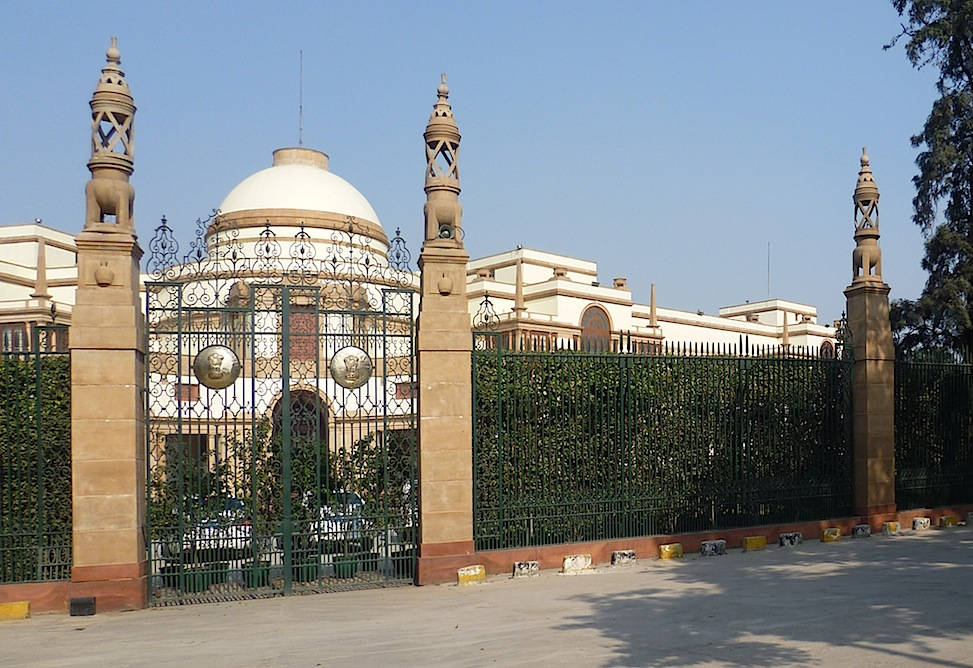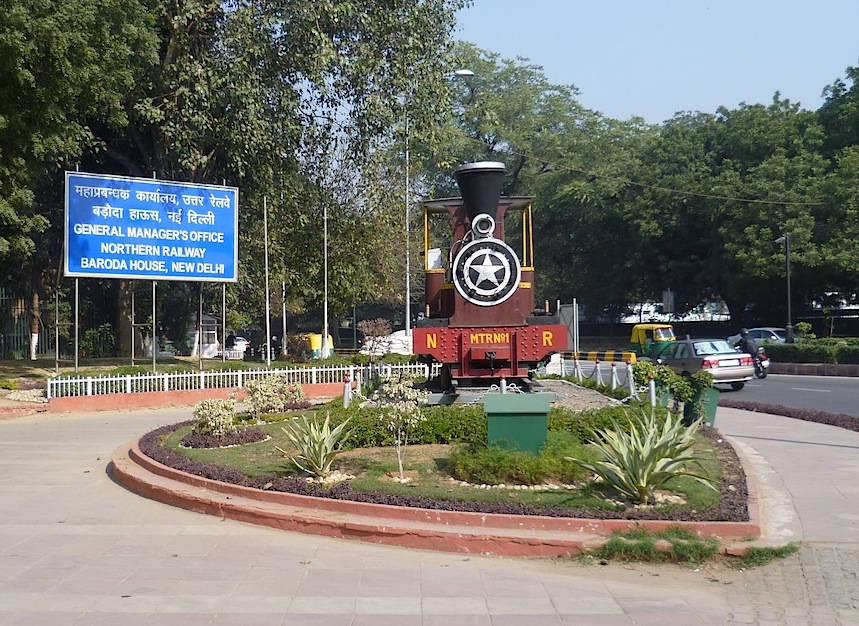Photographs by the present author. [You may use these images without prior permission for any scholarly or educational purpose as long as you (1) credit the photographer and (2) link your document to this URL in a web document or cite the Victorian Web in a print one. Click on the images for larger pictures.]

The architect Edwin Landseer Lutyens (1869-1944) was responsible not only for the Viceroy's House in New Delhi, and two important imperial monuments (India Gate and the George V Memorial nearby), but also for staff quarters, the National Archives building, and two palaces for important Indian princes on plots fronting the hexagonal junction at the end of prestigious Kingsway (now Rajpath). This one, the 36-room Hyderabad House (built 1926-28), was for the extraordinarily wealthy Nizam of Hyderabad, itself the wealthiest and most populous of all the princely states (for its earlier splendours, see Dalrymple 109-13). Naturally, the Nizam required a prominent residence in the new capital, even for occasional brief visits, and chose the architect of the Viceroy's House to design it.



Left to right: (a) Entrance portico. (b) Close-up of the gates, featuring the State emblem in beaten bronze, depicting (amongst others) Asiatic lions and the Hindi for "Truth Alone Triumphs" from the Upanishads.(c) Three-quarter view towards the right.
Undoubtedly the most magnificent of the princely houses, since 1974 Hyderabad House has been under the jurisdiction of the Ministry of External Affairs, and is used for state visits and occasions.

Adjacent to Hyderabad House on this side of the hexagon, on a similar plot, Lutyens designed a house for the Maharajah of Baroda, another of the four largest princely states. Although he planned it in 1921, it was completed only in 1936. Both erstwhile palaces were arranged in a butterfly shape, similar to the one the architect had used in Papillon Hall, Leicestershire in 1903 (sadly, demolished in 1950). They have curved entrances, domes with grand circular rooms beneath them, and symmetrical wings (see "Palaces" and Davies 233). But Baroda House, off the left of the picture alongside, was more western in style, to suit the tastes of the westernised Maharajah and his wife. For example, unlike the Nizam's Delhi residence, it had no accommodation for concubines.
As the blue noticeboard in the picture indicates, Baroda House is now the administrative headquarters of the Northern Railway, as indeed it has been since 1947. It is surely significant that visitors from the Lutyens Trust in 2003 offered no details about the interior. After all, the building has been used as offices for so many years. However, they reported that the staff there showed much pride in its past, and welcomed them warmly, showering them with rose petals ("New Delhi Newsletter"). This sort of thing might well irritate those who dislike the "Lutyens cult" in Delhi (Sengupta 26), and deplore the regimented and above all hierarchical planning of the new capital, strikingly evidenced in the placing of these residences near enough to India Gate but well below the Viceroy's House. Yet it is heartening that the merits of Lutyens' impressive buildings are still recognised — indeed, that they are being increasingly appreciated.
The old Northern Railway (NR) train engine jauntily perched on the landscaped plot outside Baroda House has its own connection with the British: it carries a small metal plate [image] identifying the manufacturers as Dick, Kerr & Co, Limited, London, and carries the words "Britannia Engineering Works, Kilmarnock 1910."
Sources
Dalrymple, William. White Mughals: Love and Betrayal in Eighteenth-Century India. London: Flamingo (HarperCollins), 2003 (Hyderabad features largely here).
Davies, Philip. Splendours of the Raj: British Architecture in India 1660-1947. London: Penguin, 1987.
"National Symbols." india.gov.in (National Portal of India). Web. 7 March 2014.
New Delhi Newsletter The Lutyens Trust. Web. 7 March 2014.
"Of Princes, Palaces and Plush Points." Reprinted from the Hindustan Times of 9 June 2011 in "Heritage Alerts." Intach (orgnisation for preserving India's pluralistic cultural heritage, which also has a worthy UK arm). Scroll down by date for this item. Web. 7 March 2014.
Sengupta, Ranjana. "Enshrining an Imperial Tradition." India International Centre Quarterly. Vol. 33, No. 2 (Autumn 2006): 13-26. Accessed via JSTOR.
Last modified 7 March 2014